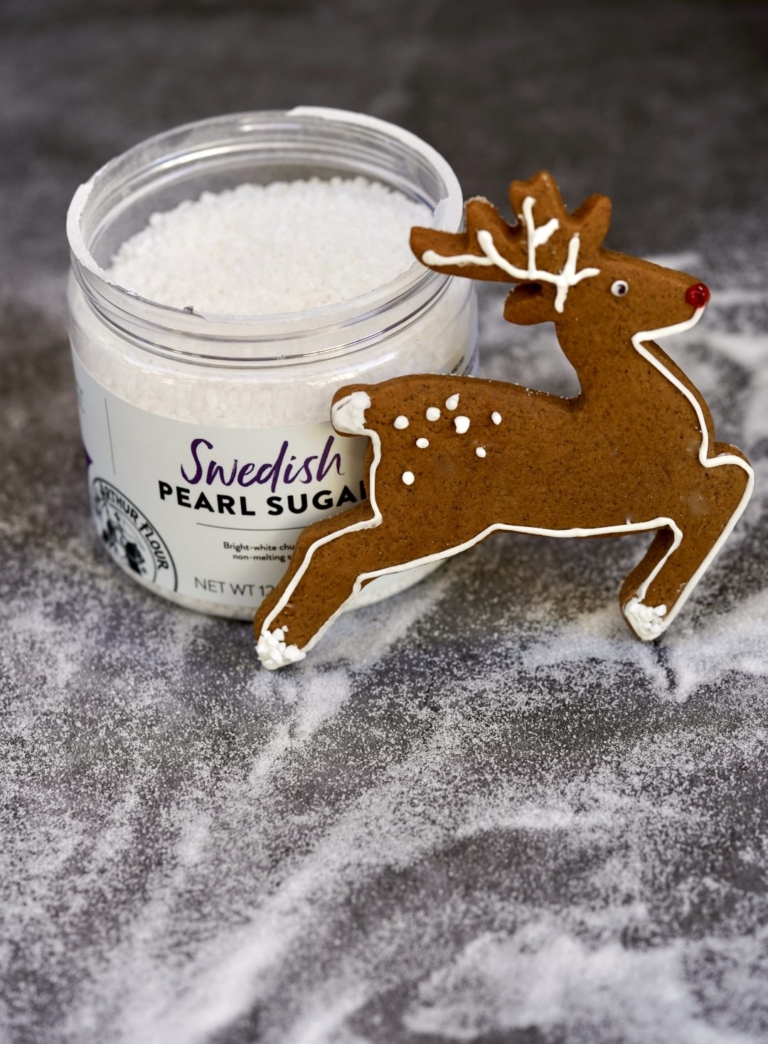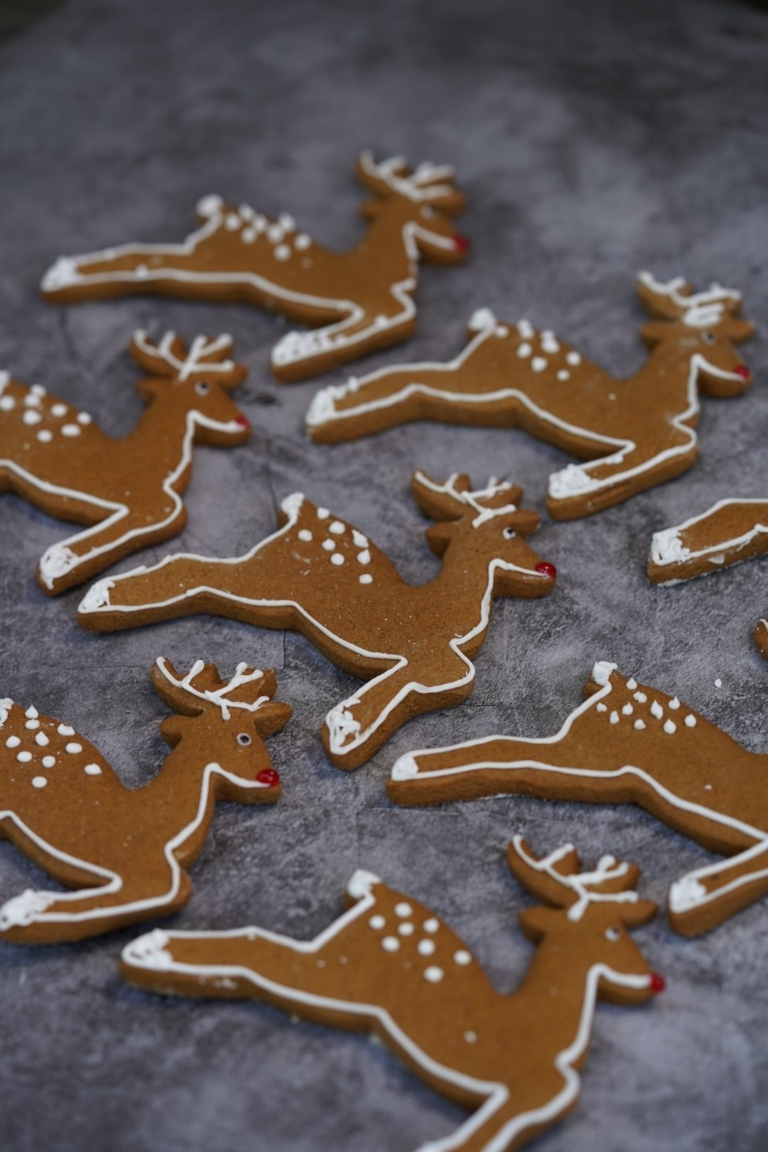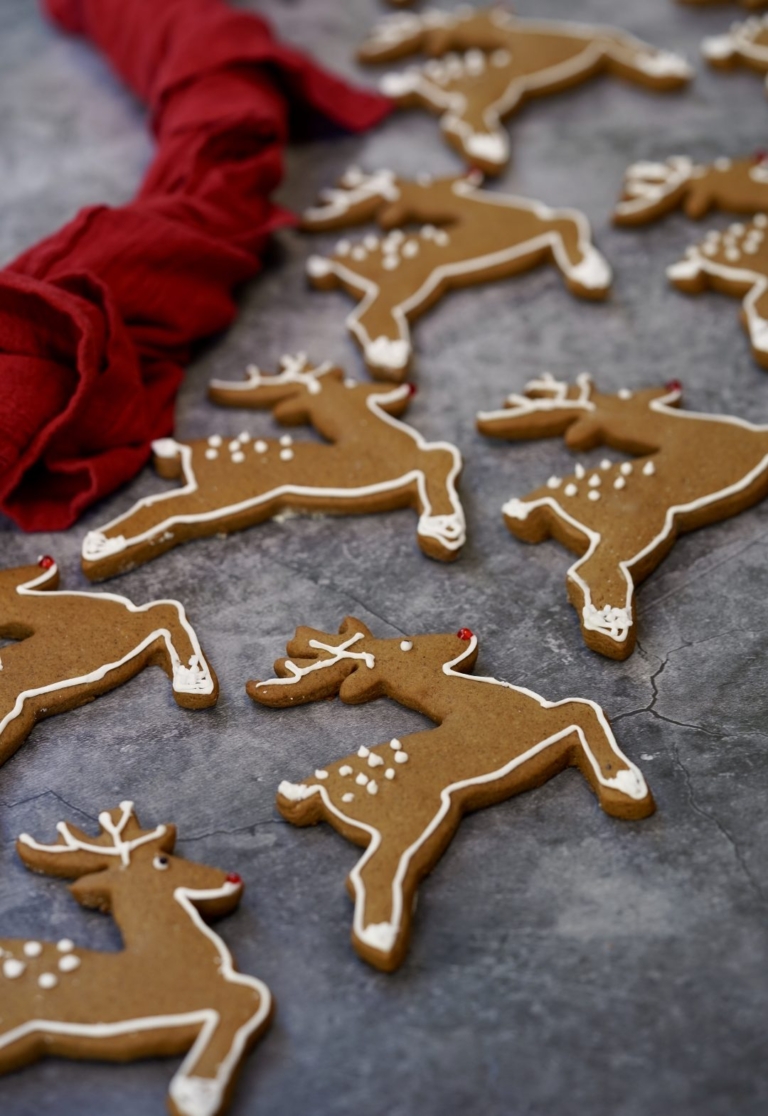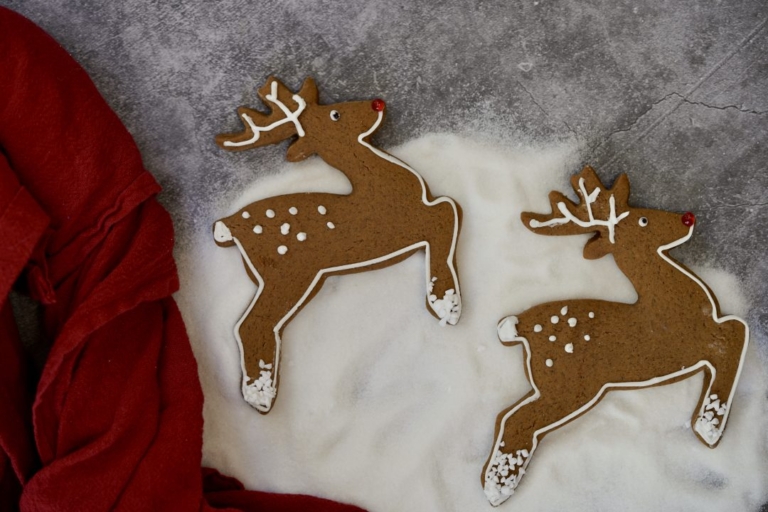Gingerbread Cookies

Tis the season. And by that, I mean cookie season. It’s what December has become, and in all honestly, I adore that. For me, baking cookies is calming, and a welcome escape from the grind and stress of everyday life (especially now). My love of cookies, which includes both making and eating them, has never been a secret, and I’m fine with owning that.
Truthfully, I find comfort in baking cookies and if you live near me, chances are, I’ve brought you cookies at some point. These gingerbread cookies are both easy and classic, like my marbled holiday cut-out cookies. Gingerbread cookies themselves, however, are unlike all others, a sweet-and-spicy cookie in one, with a rich history. To me, gingerbread cookies are the hallmark of the Christmas season and a must-make in my house.
History Of Gingerbread
Historically, “Gingerbread” can refer to a rather broad category of baked goods commonly flavored with ginger, cloves, nutmeg, or cinnamon and sweetened with honey, sugar, or molasses. Gingerbread can refer to a soft cookie, a moist cake, or even a crispy snap biscuit. But in this recipe, I’m referring to the softer variety.
According to Steven Stellingwerf, author of The Gingerbread Book, gingerbread was likely introduced to Western Europe by 11th-century crusaders returning from the eastern Mediterranean. Its precise origin is somewhat unknown, although it is clear that ginger itself originates in Asia.
The meaning of the word “gingerbread“, according to Stellingwerf, has been “reshaped” over centuries. In medieval England, it referred to any kind of preserved ginger and not a baked good at all. It was not until the 15th century that the term became associated with ginger-flavored cakes.
Gingerbread Cookies Around The World
The original European recipe for gingerbread consisted of ground almonds, stale breadcrumbs, rosewater, sugar, and, naturally, ginger. The paste was pressed into wooden molds. These cookies, called “fairings“, were often sold at festivals and fairs in medieval Europe. Commonly shaped and elaborately decorated to look like flowers, birds, animals, or even armor. At that time, gingerbread was often associated with good luck. Knights were given pieces of gingerbread as a token of good luck in a tournament. There was also a belief that if a woman ate a “gingerbread husband” it might lead to her marriage.
In the 16th century, the English replaced the breadcrumbs with flour, and added eggs and sweeteners, resulting in a lighter baked good, which was commonly baked in the form of a gingerbread man. Queen Elizabeth I became well known for serving these popular treats to foreign dignitaries, often baked in their likeness.
In Nordic countries, the most popular form of ginger confection is a thin, brittle-type biscuit that is typically associated with the Christmas season; “pepperkaker” in Norway, “pepparkakor” in Sweden, “brunkager” in Denmark, and “piparkökur” in Iceland.
The oldest recorded gingerbread recipe can be traced back to the 16th century and is kept in the Germanic National Museum in Nuremberg. Gingerbread from that city has “protected geographical indication” from the European Union, like Italian Parmigiano-Reggiano and French Champagne.
In Germany there are two popular types of gingerbread, the most commonly made in a soft form called Lebkuchen served at Oktoberfest in Munich, typically in the shape of hearts frosted with romantic messages such as “Alles was ich brauch bist du“, meaning “All I need is you”. The other is a crispier version typically used to make gingerbread houses.
Gingerbread Houses
It was the Germans who invented the concept of making gingerbread into houses, which was most likely inspired by the Brothers Grimm, who wrote about a witch’s cottage made of candy and cookies in the beloved fairy tale of Hansel and Gretel.
Gingerbread eventually came to the Americas with settlers from Europe. Molasses, which was less expensive than sugar, soon became a common ingredient and led to a much softer texture. The first American cookbook, American Cookery by Amelia Simmons published in 1796, has three types of gingerbread including a soft variety similar to mine.
My gingerbread cookie recipe is more traditional side flavor-wise, but is a versatile one that can be used for making cookies or gingerbread houses, should you desire. No confection symbolizes the holiday season quite like a simple gingerbread cookie, decorated or straight up, you no doubt have the essence of the holiday season in one bite.
Gingerbread Cookies
Ingredients:
For the Gingerbread:
- 2/3 cup unsalted butter, room temperature
- 3/4 cup packed brown sugar
- 2/3 cup unsulphured molasses
- 1 egg;1 teaspoon vanilla extract
- 3 1/2 cups all-purpose flour
- 1 teaspoon baking soda
- 1/4 teaspoon salt
- 1 1/2 teaspoons ground ginger
- 2 teaspoons cinnamon
- 1/2 teaspoon ground allspice
- 1/2 teaspoon ground cloves
For the Royal Icing:
- 4 cups confectioners’ sugar, sifted
- 3 tablespoons meringue powder
- 9 tablespoons room temperature water
- Pearl Sugar (optional) for decorating hoofs
Directions:
- For the Gingerbread: In the bowl kitchen mixer, fitted with a paddle attachment, add the butter and beat until smooth and creamy. Add the sugar and molasses and beat on medium-high speed until creamy, scraping down the sides with a spatula as needed. Add the egg and vanilla and mix on medium-high for about 1 minute.
- In a separate medium-sized mixing bowl, add the flour, baking soda, salt, ginger, cinnamon, allspice, and cloves, and whisk to blend. With the mixer on low, slowly add the flour mixture and beat until all ingredients are incorporated.
- Divide the dough in half and, using your hands, shape it into two flat disks. Wrap each in plastic wrap, place in the refrigerator, and allow to chill for at least 2 hours.
- Preheat oven to 350 degrees F. Line 2-3 large baking sheets with parchment paper. Place near your workstation.
- Remove 1 disc of chilled dough from the refrigerator. Generously flour a work surface, as well as your hands and the rolling pin. Roll out the dough until 1/4-inch thick. Cut into shapes. Place shapes about 1 inch apart on prepared baking sheets. Re-roll dough scraps until all the dough is shaped. Repeat with the remaining disk of dough.
- Place the cookies in the oven and bake for about 8-9 minutes. Allow the cookies to cool slightly before transferring to a cooling rack. Do not decorate the cookies until completely cool.
- For the Royal Icing: In the bowl of a kitchen mixer, fitted with a whisk attachment, add the confectioner's sugar, meringue powder, and water, and mix on high for 1– 2 minutes. When lifting the whisk up, the icing should drizzle down and smooth out within a few seconds. Note: There is some variation when making royal icing. If it’s too thick, add a little more water. If it’s too thin, add a little more sifted confectioners’ sugar.;
- Frost the cookies as desired. Note: Royal icing takes about 2 hours at room temperature to dry completely.








Loved this recipe. Thanks so much!
Thank you Meghan, so appreciate you trying my recipe and taking the time to tell me you liked it, very kind of you. Happy holidays!